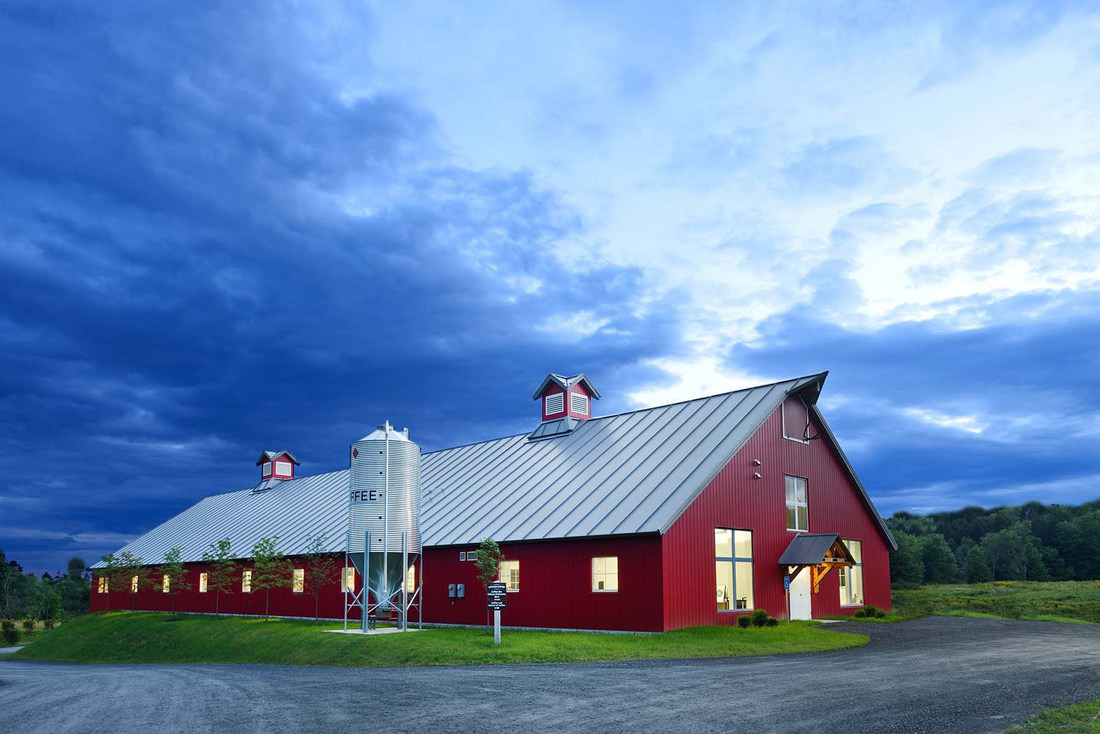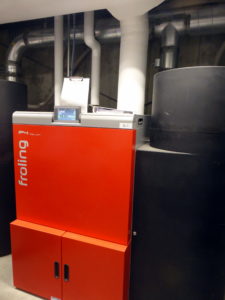
Vermont Artisan Coffee and Tea Company in Waterbury, VT. Photo Joseph Architects.
By Barb and Greg Whitchurch
On November 2nd, Renewable Energy Vermont held a press release event to announce its 5-Year Action Plan. The event was hosted by VT Artisan Coffee and Tea Co. (VAC&T) at their brand-new headquarters in Waterbury, VT, right next to the Green Mountain Club’s headquarter on Rt. 100. The 5-Year Action Plan focuses on locally harvested and prepared wood biomass fuel and advanced wood heating systems, and VAC&T was just the place to launch the new plan. (A separate article on the Five-Year Action Plan itself as well as more information on wood appliance metrics appears on page 24.)
We won’t extol the glories of coffee or the wonders of VAC&T – you already know about coffee, and the accomplishments, plans and the passion of the owners, Holly and Mané Alves, are well represented on their website. (Mané teaches coffee all over the world!) We want to focus on their choice of heating plant for their facility, which houses the afore-named roastery and its sister businesses: The Coffee Bar, The School of Coffee, and Coffee Lab International.
The facility is a 15,000 sq. ft. light industry-type building housing all four sister businesses, with about a dozen employees and as many or more coffee bar customers at any particular time. Outside parking includes two free Level 2 EV chargers and a solar canopy covering twenty employee/business parking spaces. Back inside, the coffee roaster machines themselves hail from Italy, Israel, and other countries – one roaster is wood-fired!
Speaking of wood, we’ve arrived at the crux of the “green” heating issue: the entire facility is heated by a Fröling pellet boiler. (Note: the large silo out front labeled “Coffee” actually contains the wood pellets.) This boiler is capable of very high-efficiency and clean burning (bit.do/EPA-BOILERS), and there are two 400 gallon, R-20 insulated water tanks next to it for hot water storage. This water is circulated throughout the building’s zoned radiator systems until it needs re-heating; then the boiler re-starts and burns at its most efficient rate, heating the building directly and bringing the tanks back up to temperature.

One of the two state-of-the-art, computerized, internet-connected, clean-burning pellet boilers at VAC&T. Photo Greg Whitchurch.
There is a second, matching backup boiler — just in case. These are not your grandfather’s pellet stoves. Both boiler systems are computerized and monitored over the internet allowing real-time, off-site evaluation, notification and control. A 20% cost incentive was provided through the Clean Energy Development Fund, so the long-term cost and environmental benefits of this energy choice were accelerated by quite a bit. (See incentives in VT: bit.do/WH-VT, NH: bit.do/WH-NH, ME: bit.do/WH-ME, MA: bit.do/WH-MA, NY: http://bit.do/WH-NY and pages 16 and 17 herein.)
Building designers use energy modeling software so that, based upon the particular building’s construction and the historical climate data for the site, they can be sure that the appropriate size of heating system is selected. As with residential heating systems (and cars, for that matter), installation of too large a system costs more up front, as well as requiring more fuel and creating more pollution when it’s choked down and not allowed to run at its most efficient rate.
In summary, when a company realizes that it needs a new or refurbished building in VT, the best first step these days is to contact the Commercial New Construction Program at Efficiency VT (http://bit.ly/comm-new-const-vt). With the free advice from their engineers, one can select a knowledgeable, certified, up-to-date architect and embark on a “green” and affordable path toward the best solution for any particular need.
For many years, Barb and Greg Whitchurch have heated their house, cooked, and heated their water with cordwood in a masonry stove, cookstove and a parlor stove. They are board members of Vermont Passive House and owners of a net-zero passive house in Middlesex, Vermont, a LEAF, and a Prius. (802)223-2416.
Links: Renewable Energy VT, bit.do/REVT; 5-Year Action Plan, bit.do/REVT5-Y; VT Artisan Coffee and Tea Co. bit.do/VAC-T; Clean Energy Development Fund, .
Photos
Vermont Artisan Coffee and Tea Company in Waterbury, VT. Photo Joseph Architects.
One of the two state-of-the-art, computerized, internet-connected, clean-burning pellet boilers at VAC&T. Photo Greg Whitchurch.






Leave a Reply